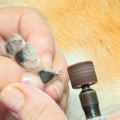Trimming or filing your dog's nails regularly should be a routine part of dog grooming, but for many dogs, trimming their nails can be extremely stressful. Urban or suburban dogs that regularly walk on the sidewalk naturally grind their nails day after day, so they may not need to be trimmed frequently. If your pet has dry skin and brittle nails that are prone to splitting, try putting a fish oil supplement, such as salmon oil, directly into your dog's food. Second, once you've isolated what component makes your dog feel anxious, you can condition it to enjoy (or at least tolerate) nail trimming.
So, now that you're an expert at how to cut dogs' nails, you might want to consider other ways to ensure that your dog is always carefree by your side. While trimming your dog's nails is something that many pet owners do themselves to save time and money, if you're in doubt, it's best to leave the work to someone with more experience. However, if your dog has extra long claws that haven't been cut in a while, he'll need to cut his nails more often to begin with. Here are 15 frequently asked questions and tips on how to make nail clipping a more enjoyable experience for you and your dog.
It depends; dogs that are used to walking on soft ground (such as parks or woods) may have a harder time controlling the length of their nails, compared to dogs that walk on hard ground (concrete or asphalt). If your dog's nails are of a healthy length, twice a month is a reasonable goal to maintain the nails. If cutting even small pieces of nails causes your dog to bleed, your goal would be to mash your nails to get them as close as possible to the fast one. On the other hand, even very active country dogs need to have their nails cut twice a week or once a month because their walks covered in grass or dirt don't wear out their nails.
Bathing your dog before you cut his nails softens his nails so that they are easier to cut and less likely to chip.






